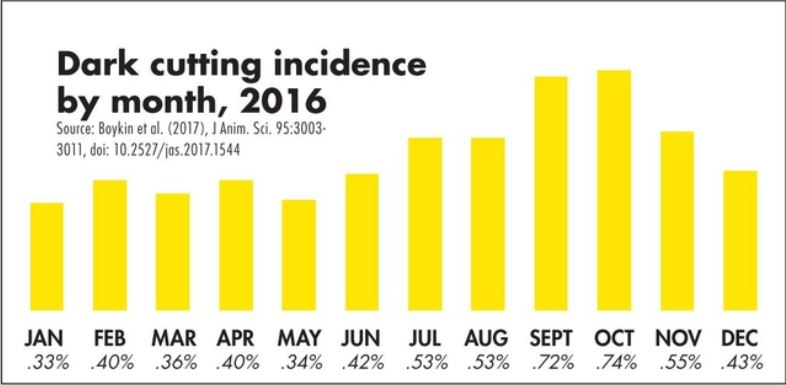Dark cutting” likely got its name from an undesirable condition in beef caused by long-term stress where the postmortem pH of the muscle remains high causing the lean to be dark in color and sometimes, if severe enough, sticky to the touch. Carcasses with this condition are referred to as a “dark cutters,” and some cattle that are observed to be stressed before slaughter may be expected to “cut dark” as a prediction of how the lean may look when the carcasses are ribbed for grading. Although dark-cutting beef is relatively infrequent, most beef carcass grid purchasing programs have discounts for them of $20 to $30/cwt, which results in hundreds of dollars of lost revenue for the cattle feeder with each occurrence. Beef processors are left with unattractive cuts to merchandise, often to the foodservice industry, where the consumer does not see the raw dark-colored muscle before it is cooked.
Stress triggers the animal to have adverse physiological adjustments such as increased heart rate and respiration, elevated body temperature, increased blood pressure that can be caused by changes in environmental temperature extremes, excitement, fatigue, and/or mishandling. For dark-cutting beef, this type of stress is often referred to as “long-term stress,” meaning that it often occurs over many hours or days compared to the “short-term stress” often seen in hogs that occurs over minutes or a few hours and results in the pale, soft and exudative (PSE) condition seen in pork.
Before and after
To understand what causes the dark-colored lean of dark-cutting beef, an explanation of how beef gets its bright, cherry-red color under normal circumstances is necessary. For the most part, energy in the muscle is stored as glycogen. At death, the muscle needs energy to maintain all of its necessary functions. It begins to break down glycogen to get adenosine triphosphate (ATP), and as a by-product of postmortem glycolysis, lactic acid is produced. Because the blood supply is gone, there is no place for the lactic acid to go but to build up in the muscle (in the living animal, the blood stream can transport the lactic acid to the liver where it can be converted back to glycogen). Over the course of the first 24 hours after slaughter, the pH of the normal muscle goes from 7.0, which is a neutral pH, to about 5.6, which is slightly acidic. This change in pH results in a bright-red color and an intermediate level of water-holding capacity, which is the ability of the muscle to hold water during storage, processing, cooking, etc. When cattle have undergone long-term stress, part of the glycogen is depleted before the animal is slaughtered with epinephrine driving this reaction as part of the “flight or fight” process. At death, the muscles of stressed cattle start with less glycogen, so there is less lactic acid produced in the muscle. Instead of the pH dropping from 7.0 to 5.6, it only drops to around 6.0 to 6.5 in these muscles. The lean will be darker colored (the higher the pH, the darker the lean), and the water-holding capacity will be much higher than normal beef, because it is further away from the isoelectric point (around pH of 5.2), where protein charges are equal and where the lowest water-holding capacity occurs. Dark-cutting beef is quite juicy because of the higher water-holding capacity, but its dark appearance is unappealing to the consumer. Additionally, its shelf life may be shorter because of a more inviting environment for bacterial growth.

On the recent National Beef Quality Audit – 2016, we had the opportunity to review camera-grading information from US beef packers, which represented over 4.5 million carcasses processed during the calendar year (Boykin et al., 2017, doi: 10.2527/jas2017.1544). For the first time, we were able to evaluate the dark-cutter incidence rate on a monthly basis with a large-scale survey. The findings supported what we knew from anecdotal information: October is the month with the highest incidence (0.74 percent) followed closely by September (0.72 percent). These months are where changes in weather begin to occur in North America with the first cold fronts following the summer months causing dramatic drops in temperature and usually accompanied with precipitation (it should be noted that in the Southern Hemisphere, it would be February, March and April for this transition from warm to cooler weather beginning). Two other months were of interest to us: July and August. Obviously, in the US, these are the hottest months, but instead of the warm-to-cold weather changes that trigger dark cutting, it is probably simply hot weather causing stress that results in a higher incidence than preceding months. Finally, dark-cutting incidence remains relatively level from December through June.
A question that is frequently asked is, why do some animals become dark cutters when stressed while most animals exposed to the same stressors do not become dark cutters? Genetic differences among cattle probably play a great role in this with some being able to handle stress better than others. McKeith et al. (2016, doi: 10.1016/j.meatsci.2016.01.016) showed that beef from dark cutting carcasses had more oxidative metabolism, more myoglobin, and less efficient energy production, which made them more susceptible to glycogen depletion before death. McGilcrest et al. (2012, 10.1016/j.meatsci.2012.05.014) found that cattle with larger ribeye areas were less likely to become dark cutters than cattle with smaller ribeye areas. It appears that inherent structural and biochemical factors in the type of muscles in cattle play an important role in whether they will become dark cutters if subjected to long-term stress.
While controlling weather is beyond our capabilities, reducing stress caused by mishandling can be mitigated by the livestock industry. Improved education in cattle transportation and handling along with improvements in animal welfare at beef packing facilities has reduced the stress that cattle are subjected to before slaughter. While dark-cutting beef may never be completely eliminated, incorporating low-stress handling procedures in loading, transportation, lairage and slaughter will pay dividends for those who embrace better cattle welfare programs.


